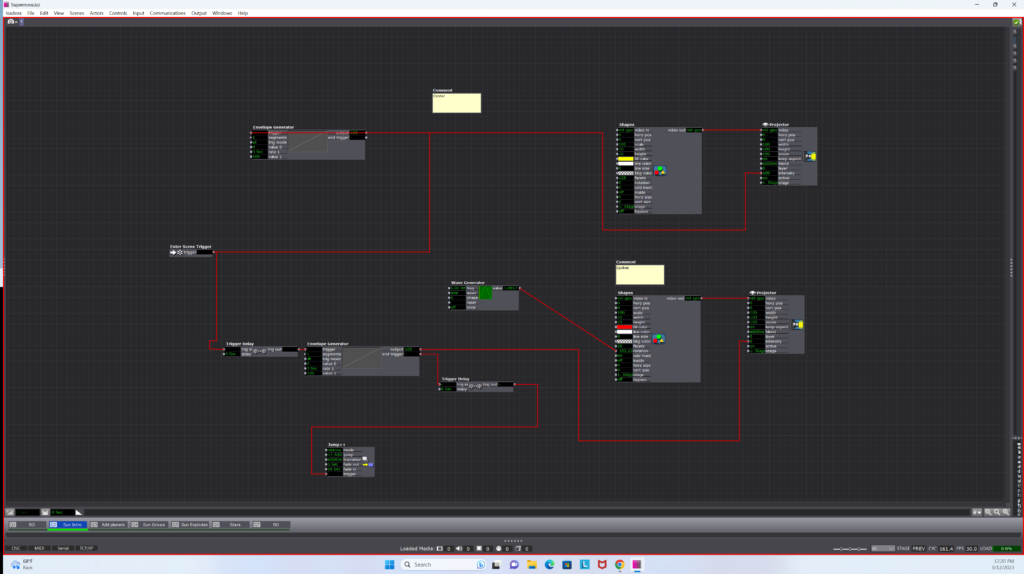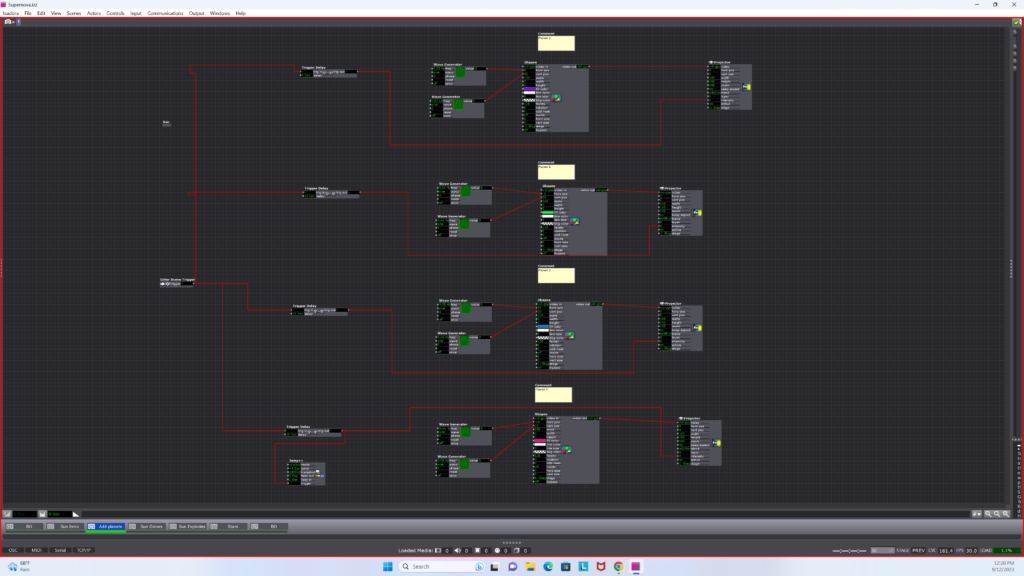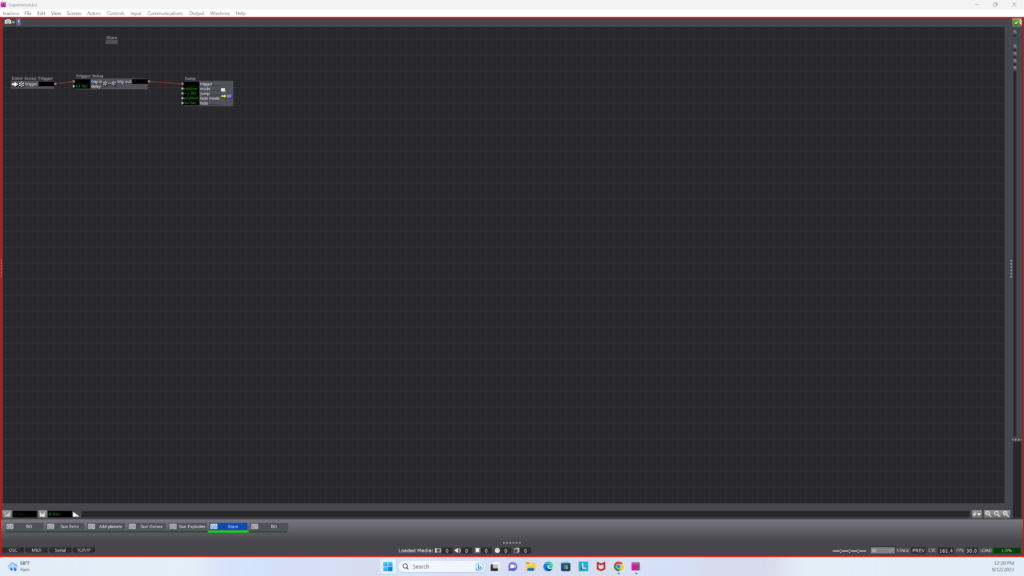Lawson: Audio Visualization
Posted: September 26, 2023 Filed under: Uncategorized Leave a comment »Here’s my audio visualization project!
Link to Isadora and Sound Files:
Sound-Reactive Project
Posted: September 26, 2023 Filed under: Uncategorized Leave a comment »For my sound-reactive project, I used analyzed the input from the microphone and used different parts of the audio spectrum to shade different parts of a moving visual “shooting star-like” field.
Ultimately I wasn’t able to get any audio routing software working on the ACCAD computer I was using (permissions, etc.) Fortunately though, I have prior experience with software like this, and I feel comfortable incorporating it into future projects (on my home desktop).
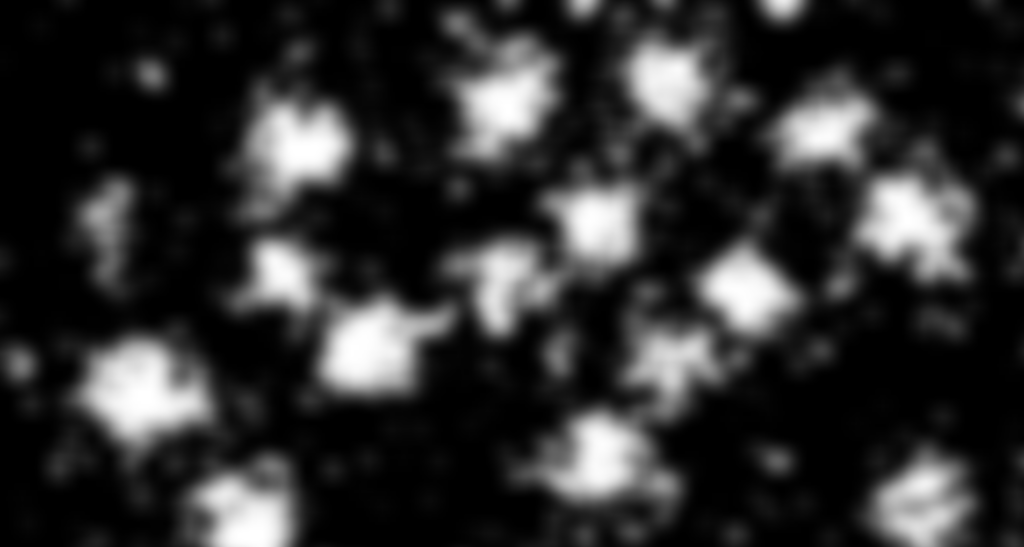

Link to Isadora file:
Pressure Project 1: “About Cycles”
Posted: September 13, 2023 Filed under: Isadora, Pressure Project I | Tags: Au23, Isadora, Pressure Project, Pressure Project One Leave a comment »Recording of the Pressure Project:
Motivations:
- Learn about Isadora
- General features/ways to create in Isadora
- Ways to organize objects in Isadora
- Ways to store information in Isadora
- Control flow
- Engage with the subject of “Cycles”
- This class uses cycles as an integral component of its processes. Therefore, focusing on the idea of cycles for this first project seemed fitting.
- Because this project encouraged the use of randomness to create something that “plays itself” (once you start it) and holds the viewer’s attention for some time, playing with indefinite cycles seemed appropriate.
- Find a “Moment of Joy”
- The “Side Quest” for this project was to invoke laughter or a moment of joy.
- When I started my 6 hours for this project, I was in a little bit of a bad mood. Consequently, I was not in the mood to create something joyful. Therefore, I decided to challenge myself to take something negative and turn it into something positive—since this artwork would feel more authentically “joyful” to me if that “joy” came from a genuine determination to find that joy within an honest acknowledgement of both the good and bad.
How the Project Supports those Motivations:
- The Storyline
- The beginning portion employs Sisyphean imagery to convey feelings of being trapped in cycles and not making any noticeable progress.
- I experimented with the number of times this scene would play to try to play it just enough times that the viewer could think that this scene was all there would be—a psychological trick that would hopefully invoke negative feelings corresponding to this theme.
- Since the animation was relatively abstract (there was no person figure included, for example), I was glad to hear from the people who watched it in class that they realized that this reference was being made.
- Eventually, it is revealed that the rocks that are rolling backwards are rolling backwards into somewhere new and exciting.
- The rock is traveling to these new places over bridges created by other rocks that had arrived there before. (I am not sure from the audience response whether this part came through, consciously or subconsciously. If I were to continue working on this project, I would change what the rocks look like to make it more obvious that the bridge is made of those rocks specifically.)
- This animation of the traveling rock cycles indefinitely, with the background effects randomized each time. (This, combined with the effect of the Sisyphean section of changing the location after the viewer starts to think that section will be the only one, had the interesting effect of causing the in-class audience to not be sure for some time that this section would repeat indefinitely. While this has some obvious drawbacks, it does arguably complement some of the themes of this piece.)
- While I want each viewer to come to their own personal interpretation of this piece, I am hoping it can encourage viewers to consider the idea that, even if we cannot see it, in the cycles in our lives we are stuck in—even the ones where the negative effects far outweigh the positive ones—we still get something each time, even if that is just a little bit more knowledge that we can use to get just a bit further next time.
- The beginning portion employs Sisyphean imagery to convey feelings of being trapped in cycles and not making any noticeable progress.
- The Technical Aspects
- This project did give me the opportunity to experiment with a variety of Isadora “Actors.” My favorite one (which this project used for special effects and textures) was the “Explode” Actor.
- I used User Actors (which I found could be used similarly to classes from more traditional object-oriented coding languages) frequently to keep things more organized and to limit the amount of copied and pasted Actors.
- I experimented with Global Values (which have some similarities to global variables from more traditional programming), the Calculator Actor, the Comparator Actor, Actors that handled Triggers, and the Jump++ Actor for control flow, especially to repeat Scenes.
- I tried to automatically set the Global Value at the start of the show, but some unknown aspect of my logic was incorrect, so I did have to remember to manually set it each time I played the show.
- Much of the control flow resulting in the final effect on the Stage could have been accomplished with just the Counter Actor, Actors that handled Triggers, and the Jump++ Actor. However, I specifically wanted to learn about Global Values using this project, and there is some symbolism involved in the fact the Scene itself truly does fully repeat (rather than just a set of steps within the Scene). This does raise an interesting question about how the way something is done can in itself be part of an artwork—but is that worthwhile when it takes more time, is less clean, and ultimately results in the same user/viewer experience?
Isadora File Documentation/Download:
PP1: Experiments in Synchromism
Posted: September 12, 2023 Filed under: Uncategorized Leave a comment »In this first plunge into Isadora, my main goal was to get to know the program through experiments in seeing. Using ‘synchronism’ as a guide (an art movement that draws analogies between color and music), I focused on orchestrating colors and the pacing between shapes.
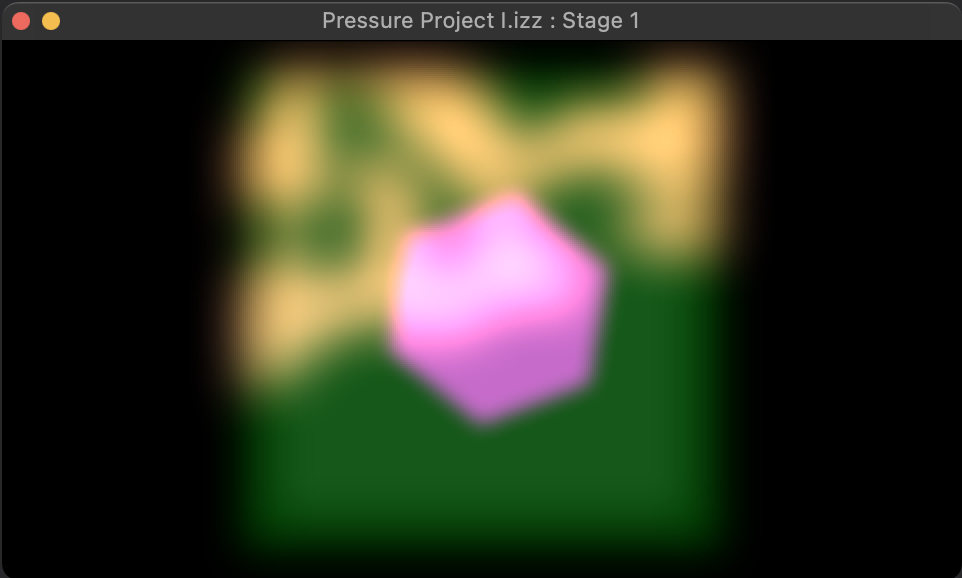
In the first scene, there are three elements at play: the pink transformer emerging from the depths, a green pulsing square sponge, and a blurry animated layer that gently envelops the two. [CG mentioned that the shapes had an organic feel, this may have something to do with the way they ‘breathe.’] The pacing of each shape was an important part of this scene, as a response to the prompt’s challenge of 20 seconds. I felt that if I could let the viewer watch the emerging pink transformer with anticipation, they would get the idea that you have to ‘wait and see’ rather than assume the loop will continue. In the programming, there was a wave generator altering color (+alpha), scale, and facets.
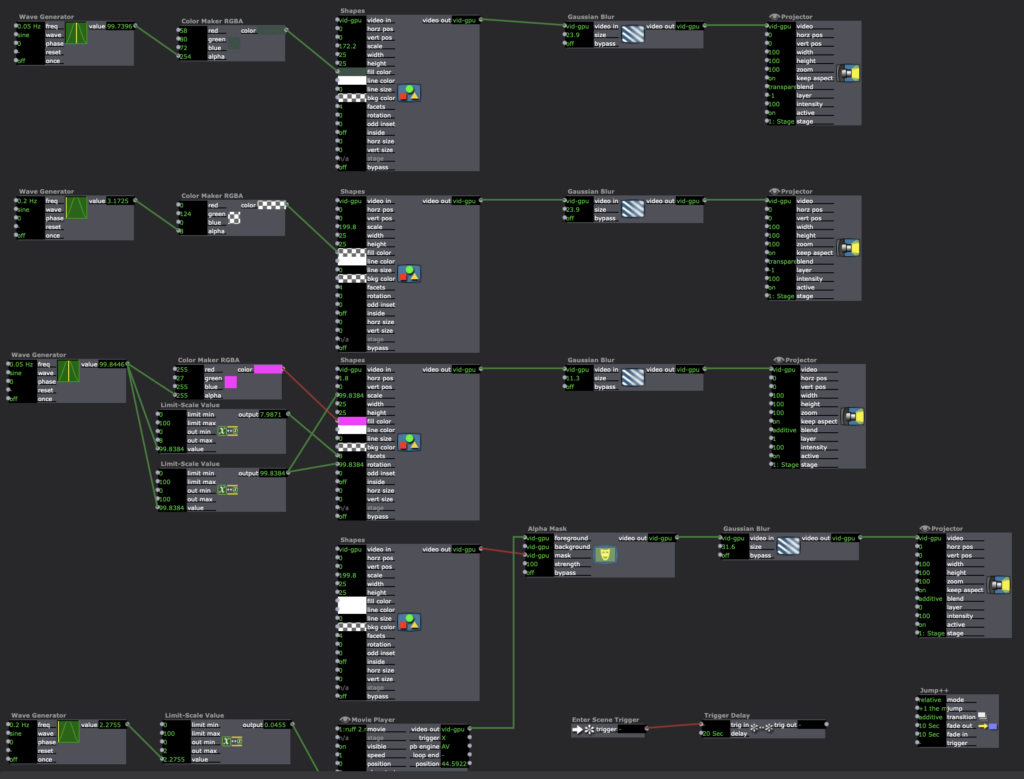

In the second scene, which was meant to be a continuation of the play of pacing, I encountered some technical difficulties (which Alex helped to resolve!) I wanted to create a prism where each square undulated at a subtly different speed so that they would influence the color of the next layer. You would ideally see all the layers in an unending loop, it sounded like a harp in my head. This worked for a good while until I created a new scene and then everything synched to one pulse, erasing the careful layering I had done earlier. Having spent so much time on that, I felt quite frustrated and gave up. The programming for this section comprised of a multitude of squares using wave generator influencing color + alpha. I placed each square so they would overlap with three vertically and three horizontally. Next time, I’ll make the squares very small rather than overlap so they act like pixels.
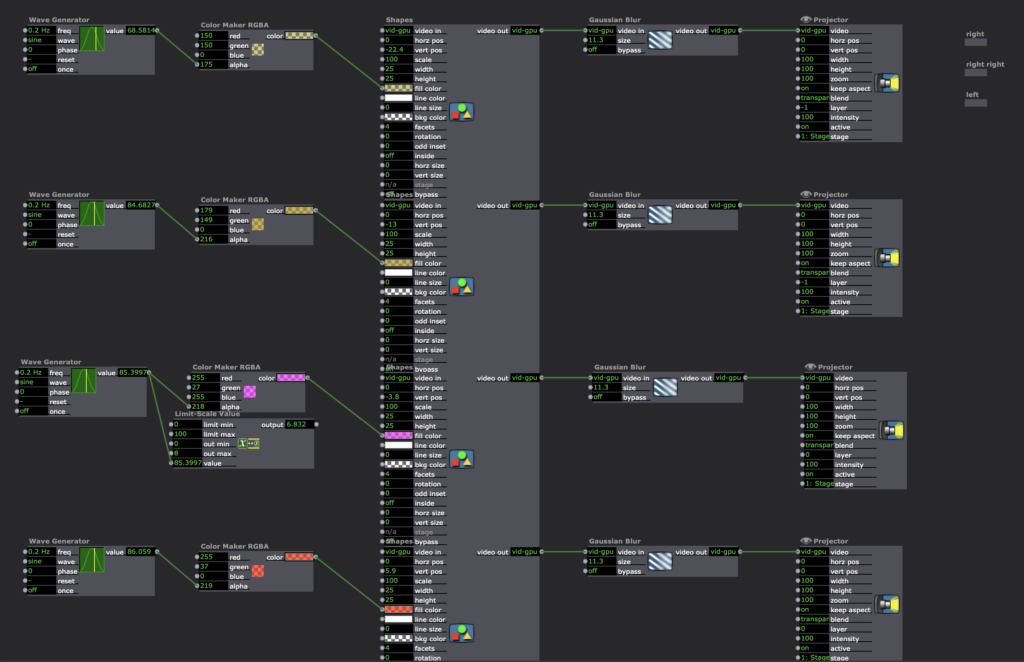
To be continued.
Conclusion: I learned a lot! I love the suggestion of the class to arrive at a place of clarity. Perhaps, another shape could emerge that is an amalgamation of the prism. I also really enjoyed seeing everyone’s interpretation of the prompts and was particularly impressed by the imaginative storytelling in every project. Kudos!
Pressure Project 1: Square Race
Posted: September 12, 2023 Filed under: Uncategorized Leave a comment »My idea for this project came about when I was considering how to create a drama that held viewers’ attention for at least 30 seconds. So I thought, why not create a race?
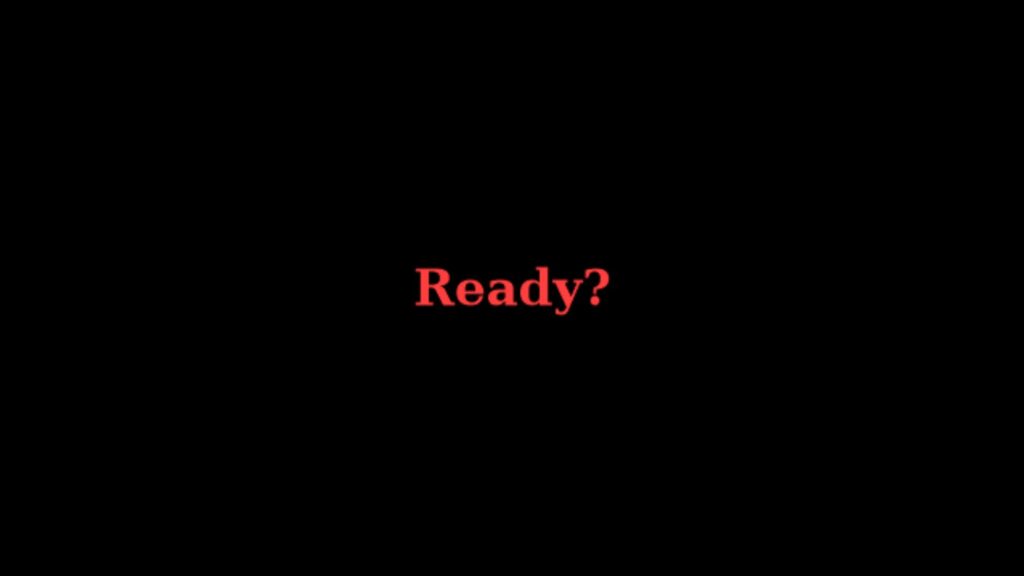
When the “Go!” button in the control panel is pressed, the race starts!

5 squares of differing colors race against each other, and the result varies every time the race is run. By far the most involved part of the project was the creation of the algorithm that propels each square. In the end, I settled on this:

The heart of the algorithm is just a straightforward ramp envelope. The square is simply moved slowly across the screen over the course of 30 seconds. The random, back-and-forth movement of the squares comes from the addition of random numbers to the envelope. I used a smoother on the random values to make the random movement of the square smooth rather than jumpy. A comparator is used to determine if the square is at any point the winner — if the horizontal position of the square (equal to the envelope output plus the random output from the smoother) is at any point greater than or equal to 49, the comparator’s condition is met, and it triggers a jump actor that changes the scene to the “victory screen” for the corresponding color (just some text):
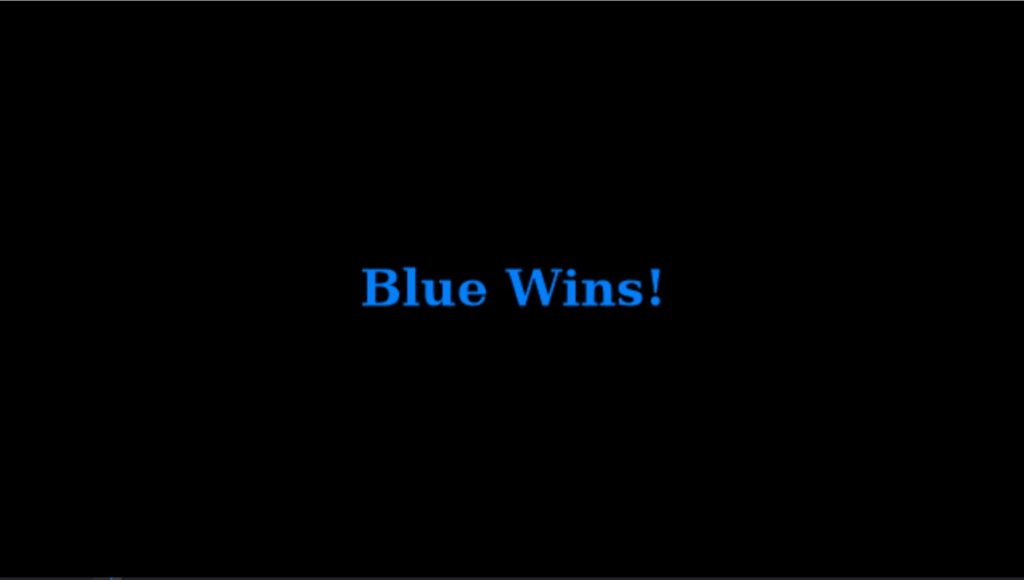
While the outcome of the race is in fact random and changes every time, in truth, due to the nature of the algorithm, the first 29 seconds or so of the race don’t impact the result whatsoever. This is because the random number generator that determines the current random displacement of the square does not take into account the previous random displacement of the square. This also means that the race will always be perceived as “neck and neck” and “anyone’s race to win” until the final second, further escalating the drama of the situation. I think this gives the race appropriate casino machine vibes — an elaborate, meaningless show to create anticipation for an outcome that is actually only determined in a brief moment.
One thing I didn’t get around to adding were audio effects and music. I wanted to add a starting gun noise that played when “Go!” was pressed, some anticipation-building music that played during the race, and a victory fanfare for each square. If I were to do this again, I would definitely add these things.
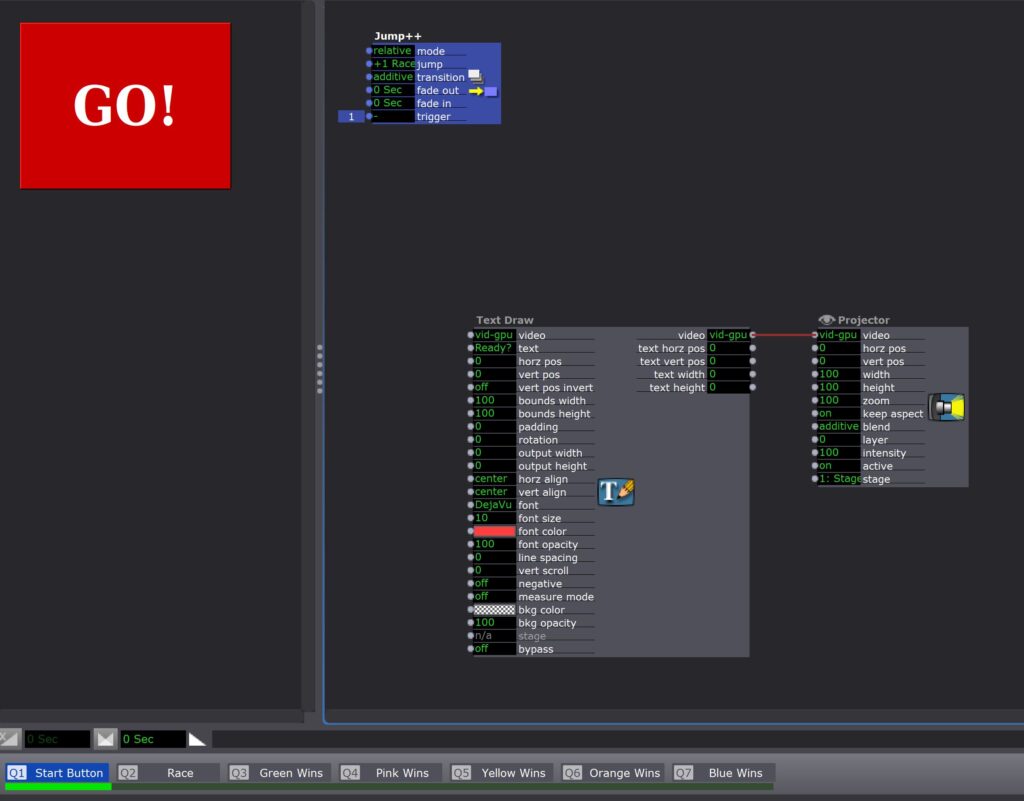
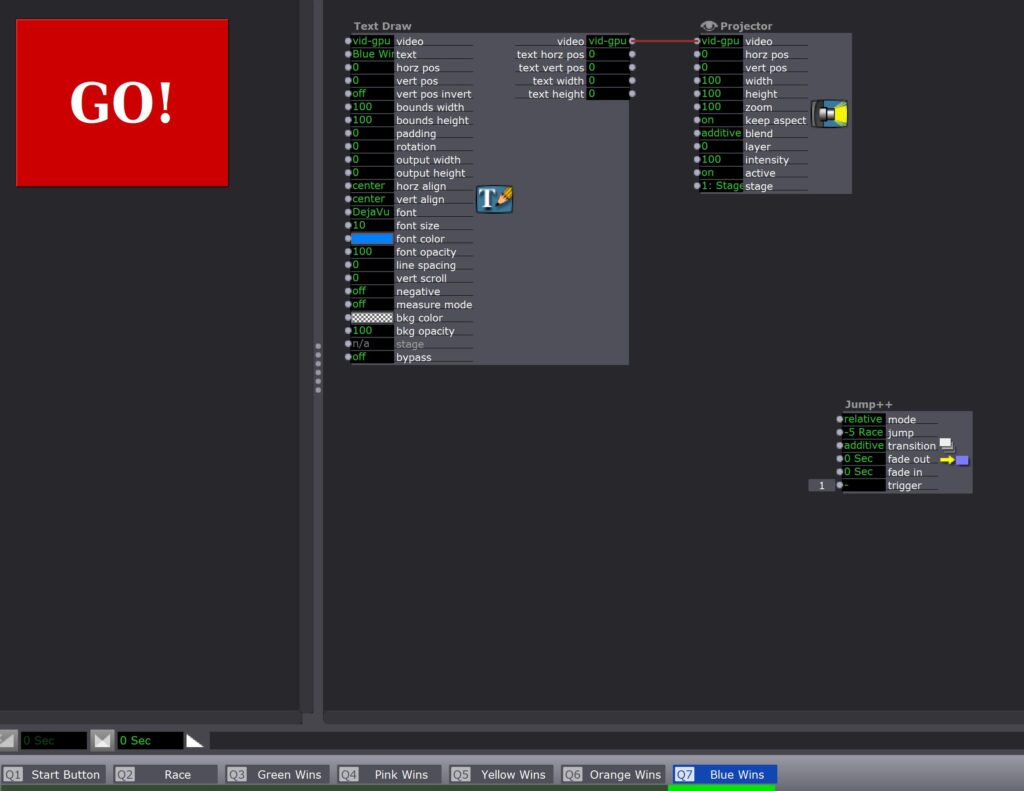
Reflection on PP1
Posted: September 12, 2023 Filed under: Uncategorized Leave a comment »One of my goals for this project was to create an automatic transformation that keeps changing its shape randomly. So, my agenda was how to build a loop circuit which never repeat the same motion.


Firstly, I made some looping structures; Wave actor automatically loops so it was useful. Envelope actor has the ending point, but I found that if I connect end trigger to start trigger, it forms a loop circuit. Then, I can put Trigger Delay or the other Envelope actor to make the loop more complex.
Here’s an example of a looping part.

The next task was to insert some randomness. Random actor was one of the solutions, for sure. But I also used the differences between frequencies to make transitions seems random (it’s not actually random as different pitches make a long period loop, but it behaves like random on our eyes at least).
Here’s example; I used three Wave actors to change RGB values. As each frequency is different, the whole color transition seems random.

I found some actors to adjust values. For example, to make a star shaped polygon (an offset regular polygon) whose facets randomly change, I had to convert values generated by Random actor into integer even numbers. I used Float to Integer actor to get integer numbers and connect it to Calculator actor which multiplies it by 2 to make even numbers.
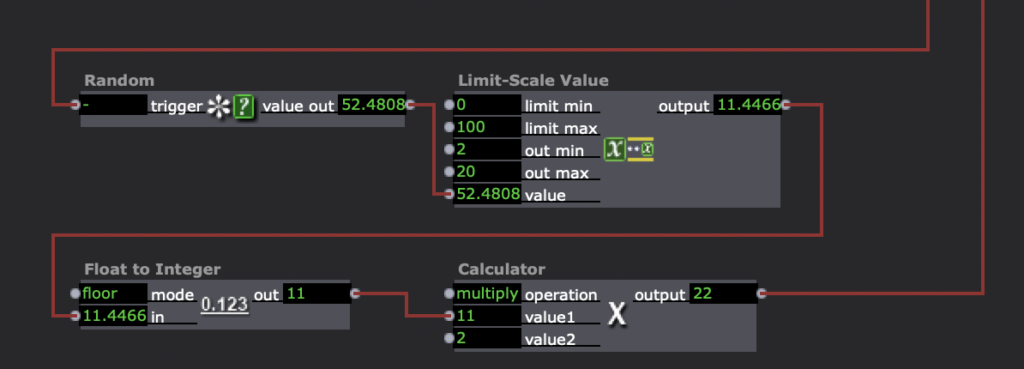
Throughout those process, I slowly realized that what Isadora’s chart of actors actually represents is definitely coding; accepting triggers, convert input values into outputs, and send values or signals to the next lines.
Also, it reminded me of building an electric circuit; make a loop of multiple signals by connecting modules.
For me, rather than a final output on Stage monitor (I’m certainly satisfied with it for sure), the realization of this sense (Isadora is coding/circuit building) was the biggest achievement.
Pressure Project 1: Sunrise
Posted: September 12, 2023 Filed under: Uncategorized Leave a comment »For Pressure Project 1, I created a short scene of a moon setting that transitioned into a sunrise using Isadora.
Step 1: The Idea
Coming up with an idea for this project was probably one of the hardest parts for me because I did not have any ideas when I first sat down to work, but after a few minutes of playing around in Isadora, I started to come up with ideas.
Step 2: Iteration
My first idea started with colored rectangles that I wanted to have change colors over time, so I started working on rectangle placement. While working, I got another idea that excited me more than the one I was working on and scrapped the original concept. This new idea was going to play with negative space and would be entirely in black and white. I spent a lot of time working on trying to make the very first scene look the way I wanted, with a half black, half white circle on an opposing black and white background, but the split color circle ate up way too much time and I didn’t end up getting it to work the way I was hoping. From the ashes of the circle rose another idea: a sunset.
Step 3: Sun and Moon
In the time that I had left with this project, I started by making one of the circles yellow with an orange outline and deleted the extra one. Then I started to play with the position of the sun in the sky, making sure the action was not happening too fast, as sunrise is a naturally slower transition. Next, I used the Envelope Generator++ and Color Maker RGBA actors to make the color of the sky change from black to a pink-orange, making sure that this was happening in sync with the change in position of the sun. To add another element to my project, I created a new scene with a light yellow circle on a black background that would be a moon. I made the action of the moon going down slightly slower than that of the sunrise and I also added a TT Polka Dot GLSL Shader actor in an attempt to give the look of stars, though I did not end up having time to adjust this very much.
Step 4: Timing
Figuring out the timing of everything in this project took a lot of time. Coordinating the sun rising with the background color change, making sure the action wasn’t happening too slow or too fast, coordinating this with the timing of the mood falling, then adjusting the transition between the two scenes was more of a challenge than expected. If one of my elements was off by a couple seconds, then something looked off, so I spent what time I had left adjusting timing on several actors. I finished off the project by adding a button to start the show, as I forgot how to make it loop, but I did remember how to quickly program a start button.
Isadora File & Screen Capture

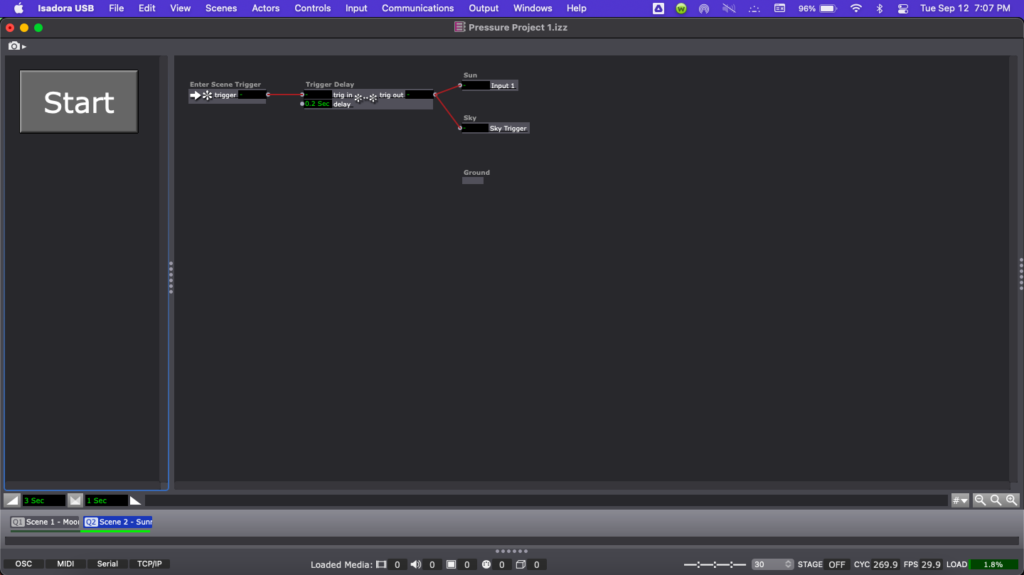
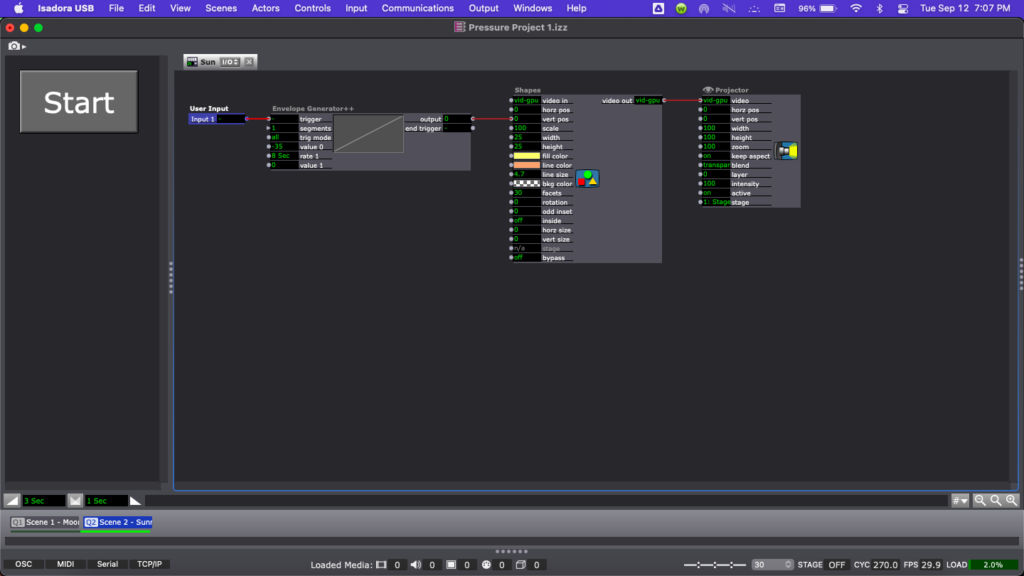
Reflection
I feel like this pressure project overall was a good introduction to both Isadora and the idea of a pressure project. While I did choose to mostly use actors we had already discussed in class, I do think there was enough time to play around with unfamiliar actors as well. Most of my time was spent on playing with Isadora and working on ideas that came before this one, but I don’t consider that to have been a waste of my time. To me, this time spent on elements that did not end up in my final project was spent equally as well because the final product is just an iteration of my previous ideas. I would have liked to do a little more, but I am happy with my project overall.
WORK > PLAY > WORK > PLAY >>>
Posted: September 12, 2023 Filed under: CgRyan, Isadora, Pressure Project I, Uncategorized | Tags: Isadora, Pressure Project, Pressure Project One Leave a comment »My goals for Pressure Project #1 were to deepen and broaden skills working in Isadora 3 and to create a motion piece that could hold attention. The given Resources were 6 hours and a minimum of using defined Actors: Shape, Projector, Jump++, Trigger Delay, and the Envelope Generator, and that would auto-play.
PROCESS
Pressure Project 1: TAKE 1 took 3 hours, and though I learned the basics of scene transition and shape control and video placement, I was not satisfied with how the scenes progressed and connected: I had not taken the time to create a defined concept. (When feeling “time pressured” I sometimes forget what one of my most respected design teachers at ArtCenter said “To save time, take the time to create a concept first.”)
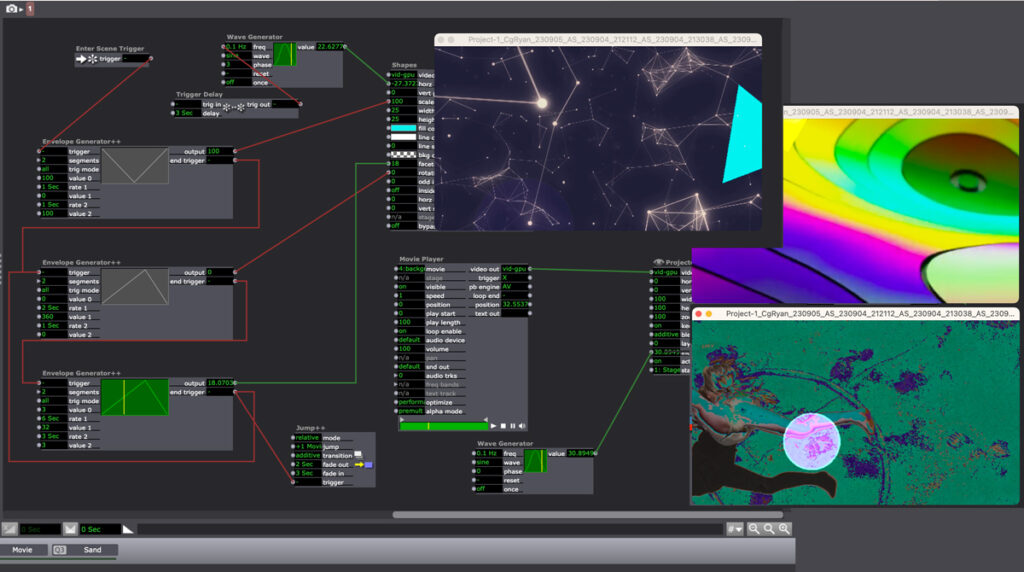
Pressure Project #1 – TAKE 1
CONCEPT
I am both a designer and an artist, and creating a balance between personal work [PLAY] and paid client projects [WORK] has been an ongoing battle over my careers. I decided I wanted to symbolize this “dance” between WORK and PLAY in my motion piece. Conceptually, I think of WORK as a rectangle, or a “frame” that defines the boundaries of both Resources and what the Valuation criteria are. When I think of PLAY, I think of circles, more open and expansive, and playful. When I think of the combination of these 2 concepts, I see a choreography between grace and collision, satisfied expectations and for serendipity. When deciding on the pacing and transitions of the whole, I wanted to create an “endless loop” between WORK and PLAY that symbolized my ubiquitous see-saw between the two poles. An endless loop would represent “no separation” between WORK and PLAY: my live-long goal of to have work that feels like PLAY, and to WORK meaningfully at my PLAY so that it is worth the currency of my life force: time and energy.

Concept: WORK > PLAY sketch
ADDITIONAL TUTORIALS
I found an additional Isadora tutorial “Build it! Video Porthole” by Ryan Webber that demonstrated skills I wanted to learn: how to compose video layers with masking and alpha channels, and another demo of the User Actor. From this tutorial, I was inspired to use the Alpha Mask actor to make the WORK > PLAY > repeat cycle explicit. I decided to use the letters of the two “four letter words” to explicitly to represent my history as a communications designer, and to alternate between a more structured motion path using the squares and a more playful evolution as the piece transitioned to circles, then a finale of a combination.
LIMITED REMAINING TIME: 2.5 hours
To respect the time limit of the project, I used an application that I use in both personal art “play” and client work, After Effects, to quickly create three simple animations with the WORK + PLAY letters to use with the Alpha Mask actor.

After Effects alpha masks
To save additional time, I used a combination of motion pattern videos I have used in earlier projection mapping projects. I used the Shapes and Alpha Mask actors in Isadora to combine the elements.

Scene 1 – 3 stills: videos in alpha masks
To create the endless “loop” transitions between the three scenes, I used the Trigger Delay actor on each of the three scenes, using the jump value of “-2” to return to scene one.
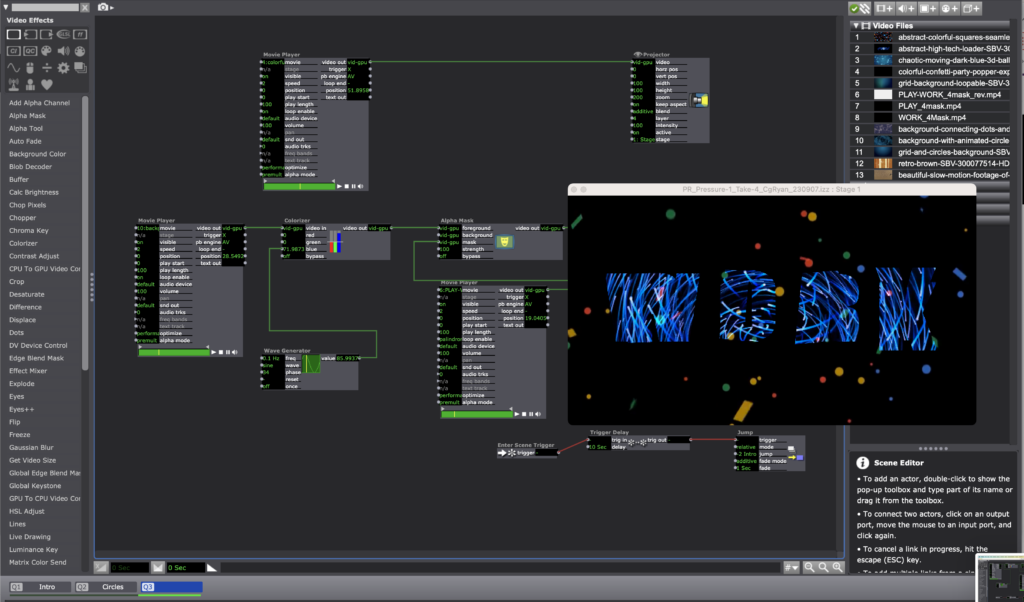
Scene 3: Trigger Delay and Jump++ to return to Scene 1: “-2”
To export the Isadora project to video to post online, I used the Capture Stage to Movie actor. I look forward to the next Pressure Project!
PP1: Good Morning, Boredom
Posted: September 12, 2023 Filed under: Uncategorized Leave a comment »Below is a recording of my “finalized” Pressure Project 1 output:
The Creation
I originally had the idea for a DVD-like screensaver creation about an hour into my work on a completely different idea. I hadn’t fallen in love with it, but had sank a decent amount of time in it. It involved hexagons of various sizes popping up into view, revealing a picture I had taken underneath. While trying to move one of the hexagons across the screen, it shot in a diagonal all the way into the top right corner. I instantly felt a dopamine hit since it reminded me of watching the DVD screensaver as a kid and waiting for it to hit a corner. I immediately switched course and started working on getting a square to bounce around the screen in a way where it wouldn’t immediately hit the corner.

Above is a screenshot of the user actor for the shape acting as the DVD logo itself. By using the triangle wave in the wave generator, I was able to make the square “bounce.” It took me some time to figure out how to keep the square changing color only at the moments where it hit the sides, and I still don’t think that part works every time. I used the HSBA Color Maker actor to help randomize the color each time.
While I knew I could probably hold 30 seconds of the audience’s attention (or at least my own attention) with just the screensaver, I thought it would be interesting to subvert expectations by adding another square. I also wanted to incorporate randomness somehow, so I made the other squares move around and change color randomly.
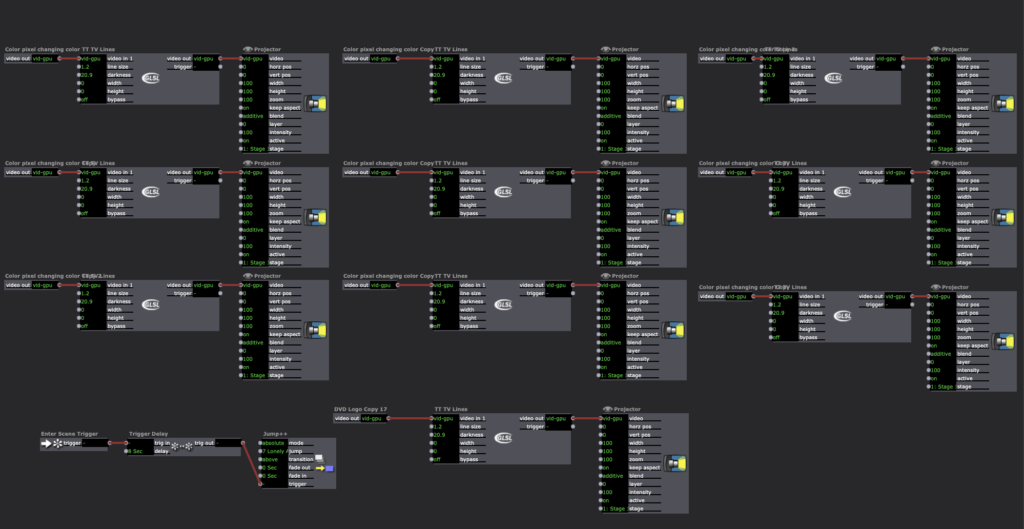
Above is a picture of scene 6, where all of the boxes appear and start moving around the screen. After playing with the “meat” of it for probably around 4-5 hours, I added the beginning and ending. I ended up picking Singin’ in the Rain for the movie framing device since it’s seen as a classic–everyone knows “Good Morning”–and I liked the idea of having a song being paused in the middle. It also helped add the feeling of nostalgia I was going for since it’s an older movie. Below is a video of my Isadora screen while the action played.
The Performance
After six hours of working on a project, I tend to get stuck in the role of creator and have a hard time seeing things from an outside perspective. I’ll admit that I worked on the whole things in two sittings (which was not a great idea in retrospect). By the time I was “done,” I was so immersed in my work that I had no idea if it even made sense anymore. This wasn’t a great feeling, but in a way, it made the experience of watching the class during the performance much more rewarding. I suddenly was able to see the piece in a new light, especially since people were so vocal with their reactions.
CG’s point about the first square going on the hero’s journey resonated with my original thought; once I’d created the other squares, I realized that I had made a main character and edited the rest of the project to reflect that. What Arvcuken said about it being a “series of interruptions” also stuck out to me. I had a hard time summarizing the piece, but that was an eloquent and accurate way to put it.
Finally, the class’ guttural reaction to the first time the screensaver showed up was awesome to watch as the creator of the piece. While I was hoping for more of a lighthearted response, it was in a way rewarding to see the sudden frustration everyone felt knowing that the box would take a while to hit the corner. Even though it wasn’t a positive feeling, I enjoyed getting to see such a large reaction over what I had made. I also apologize for making something so frustrating–once I saw it I couldn’t pass it up.
Lawson: Pressure Project 1
Posted: September 12, 2023 Filed under: Nico Lawson, Pressure Project I, Uncategorized | Tags: Isadora, Pressure Project, Pressure Project One Leave a comment »For pressure project one, I was inspired to create a narrative as opposed to an infinite loop. I have recently been interested in outerspace and interstellar processes and decided to create an animation of a supernova, albeit in a simple, geometric representation.
To create a sense of time and scale, I played with trigger delays, envelope generators, and the fade in/fade out aspects of the jump++ actor. Playing with the fade in and fade out aspects of the jump scene actor helped me to create the perception of a camera zooming out to show the entire solar system. Trigger delays and envelope generators allowed me to establish movement of particular elements and create a sense of passing time. Because I did not yet know about the spinner actor I used a wave generator to manipulate the planet shapes’ horizontal and vertical positions long an elliptical pathway. To prevent them from traveling together in a straight line, I gave each planet a different scale limit and used trigger delays to offset the initiation of the planets’ pathways. For this reason, the planets appear to move in a random pathway across the screen, rather than circular orbits.
To create the sun’s “explosion,” I used an envelope generator to increase it’s scale over 10 seconds. In the next scene I used the shimmer actor to disrupt the pointed red shape and the dots actor to disrupt the yellow circle. The seeming “fizzling” of the sun was achieved through the cross-fade between scenes.
If I was to improve this patch, I would want to first, reduce the load on the Isadora program and offset the limited power of my computer’s processor, and second, create an orbit for my planets using the spinner actor. I might also use the explode and particle actors to create a “real” explosion of the sun rather than the illusion that I created using the shimmer actor. Additionally, I think that I could use the layer functions and blend mode of the projector actors to allow the planets to disappear and reappear around the sun, rather than showing up as bright spots when the images overlap.
Upon further reflection…
From a storytelling and pacing standpoint, I wish that I had allowed the scene in which the planets appear to stay longer. For me, the scene jumps to quickly after the last planet appears, rushing the story rather than establishing the presence of a solar system. For similar reasons, I wish that I had used a similar strategy of trigger delays and envelope generators to allow the stars to appear at the end of the story. I think that the narrative would have had a more satisfactory ending had I allowed the stars to slowly establish themselves rather than appear all at once. It would have also been a more satisfying final image if I had used a particle generator to create a background of smaller stars- this would have created significantly more depth to the screen.
